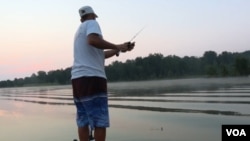Most mornings, when the weather cooperates, angler Mike Sielicki can be found out on the water in Fredericksburg, Virginia — about an hour’s drive from Washington — trying to hook a species of fish that was once considered a dangerous threat to the surrounding aquatic wildlife.
“To me, it’s the best fish that ever hit the United States,” Sielicki says. “I hope it winds up going in every body of water so everybody can enjoy it.”
Sielicki has fished for northern snakeheads for 20 years, since they first showed up in Potomac Creek, a shallow inlet that feeds into the Potomac River, a major Washington-area waterway. Through his company, Apex Predators Potomac Creek, he takes paying customers out on his boat to fish for the invasive predator, which originally came from Asia.
“I have a fair amount of people that come from out of the state, out of the United States, that come fish with me,” he says on a quiet August morning when the snakeheads are proving elusive so far. “The water here is very shallow, gets very grassy, and that’s their perfect habitat.”
Snakeheads first appeared in the Washington area in 2002. Almost immediately, local wildlife officials sounded the alarm. Scientists worried that snakeheads would decimate this area’s native predator fish populations, including the prized largemouth bass.
“The Potomac River is a renowned destination throughout the country for bass tournaments and sport bass fishing. It’s huge,” says John Odenkirk, a fisheries biologist with the Virginia Department of Wildlife Resources. “And so, that was the concern, that this fish [snakehead] was going to destroy that, because they were kind of the same level at the top of the food chain.”
Snakeheads, which can grow to more than 83 centimeters long, have pointy teeth and can breathe air, which means they can survive out of the water for several days — as long as their skin remains moist.
Snakeheads also spawn twice a year, while similar level fish only spawn once a year. Officials worried these unique qualities would give snakeheads the edge over native top-level predators.
“So, on paper, it’s like, ‘Wow, they got some competitive advantage here.’ … What was driving the fear was that the abundance of snakeheads would get so high they would just overwhelm the system. That never happened,” Odenkirk says. “They never got to the point where they could threaten the stature of the bass, because there weren’t enough of them.”
Odenkirk says snakeheads aren’t dominating their environment in part because predators, including birds and other large fish, found them. And he says the snakehead’s natural prey, including smaller fish, instinctively adjusted to its presence.
The fish populations that snakeheads prey on have not declined, which suggests the snakeheads aren’t having a negative impact on the environment, Odenkirk adds.
The fish is also popular with anglers, which has also kept the snakehead population in check. Their firm, mild-tasting white meat makes them a sought-after delicacy.
“Like swimming chicken,” Sielicki says. “It’s the most hardiest piece of meat that you’ll ever get.”
Despite this suppression, in the United States the snakehead population has become most abundant in the Washington-area’s Potomac River and its tributaries, and in the southern state of Arkansas, where the fish used to be bred for food until 2002, when federal officials banned the practice.
Even though snakeheads haven’t had a noticeably negative impact on the ecosystem, wildlife officials aren’t prepared to give the invasive species the all-clear.
“If they get in somewhere different, maybe where we have a threatening or endangered fish, where there’s not as much diversity in the fish community, there could be some unwanted impacts in a situation like that,” Odenkirk says. “So, there’s still that hesitancy to sort of embrace the fish all across the board.”
Years ago, worried wildlife officials advised people to kill snakeheads if they caught them. But a recent state survey showed that about 40% of people who catch this prized fish in Virginia now choose to release it back in the wild.
But not Sielicki, who relishes harvesting his catch, which he does on this morning after an hourslong lull, when the determined fisherman finally hooks a 63-cm snakehead.
“Back up! We’re getting ready to put him in the boat,” he calls out. “Let’s see if we can get another one.”



